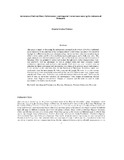Borankana (phathisi) music performance, learning and transmission among the Bakwena of Botswana

View/
Date
2012-03Author
Phibion, O.
Publisher
IJSRE, http://www.ijsre.comType
Published ArticleMetadata
Show full item recordAbstract
This paper is aimed at discussing the information contained in Borankana (Phathisi), traditional
music practiced by the Bakwena in the Kweneng District of Botswana. The paper was conceived
through the collaborations between ethnomusicology classes and their subjects/respondentsin an effort to better understand Borankana traditional music performance, and its daily uses today. This paper addresses not only the traditional music, but also the traditional learning and transmission of the music. Data was gathered by author and students through kgotla (tribal administration) visits, oral interviews with the informants, as well as internet search and other secondary printed information repositories such as books and journals. Oral interviews were recorded using an
audiotape for future referencing and photographs were taken of the practical music performances. It was evident in the interviews that for the Bakwena of Botswana, Borankana music was
traditionally used for entertainment by both young and old people. However, it was also evident
that dancing activities were largely dominated by men and boys while women sang, clapped hands and ululated. Historically, Borankana was performed during tribal activities only. Now it mainly
used by men in day-to-day activities for entertainment with women accompanying through
singing, hand clapping and ululating. Changes in costumes and the materials used to make instruments over time is also discussed.
